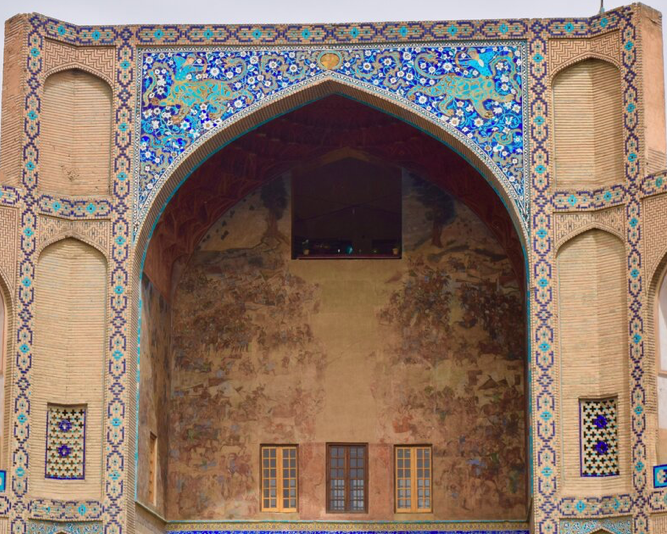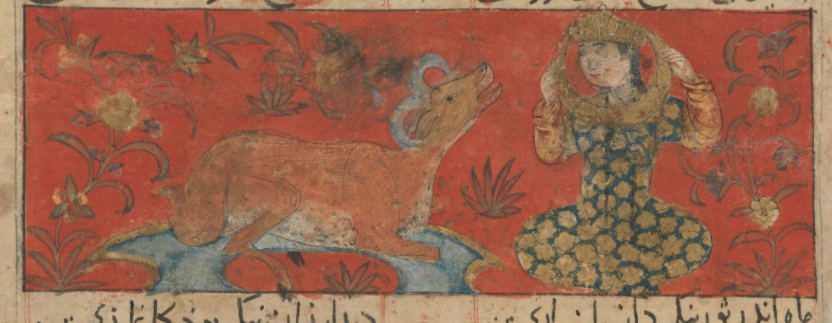Thread: In which I would like to talk about a beautiful manuscript entitled "The Free Man's Companion to the Subtleties of Poems" written by Jajarmi around 1341AD in Isfahan, Iran. Its illustrations hide some ancient animal calendar markers. And ancient gods...
But first this...
But first this...

This is the symbol of Isfahan. Two of these images decorate the entrance into Isfahan's Grand Bazaar, one of the greatest and most luxurious covered markets in Iran, built in 1620AD... 

And they apparently depict Sagittarius...How do we know this is Sagittarius? Well, because inside of the "The Free Man's Companion to the Subtleties of Poems" there is an illustrated poem about the moon visiting the houses of 12 zodiac signs...And this is Sagittarius... 

Here are all 12 illustrations. I want to thank @handarziha for alerting me to this beautiful book. BTW @handarziha, I found missing pisces illustration🙂 and have added it to the start of the first panel where it should be... 







The zodiac used is the European zodiac, with constellations: Aries, Taurus, Gemini, Cancer, Leo, Virgo, Libra, Scorpio, Sagittarius, Capricorn, Aquarius, and Pisces... 

Why European zodiac? Firstly because all the animal signs mark significant lifecycle events of the depicted animal, in Europe...I talked about it here (I promise I will finish it soon, but here is the gist) oldeuropeanculture.blogspot.com/p/zodiac.html 

This totally improbable "coincidence" made me wonder if this is indeed a coincidence...Which led to the discovery of the ancient animal calendar markers, which are found in all Eurasian and North African cultures since Neolithic...And have nothing to do with stars...
Also, the oldest depiction of this type of zodiac circle was found in Croatia, in the Nakovana cave. Not surprising at all, if you know what this "circle of little animals" (that's what zodiac means) actually represents...I talked about it here oldeuropeanculture.blogspot.com/2020/07/nakova… 





More about animal calendar markers found in ancient cultures, start here oldeuropeanculture.blogspot.com/p/animal-solar… then check the rest of the blog posts I still didn't add to this page, and finally check my twitter threads I still didn't convert to blog post...I am 7 months behind now...
Anyway, lets get back to the Isfahan zodiac, and start by saying that it is important to know that the manuscript was written in Isfahan. Cause the animal calendar markers found in it describe Isfahan climate, hydrology and ecology...
Isfahan is located at the foothills of the Zagros mountains on a fertile soil along the Zayandehrud (en.wikipedia.org/wiki/Zayanderud) River...This is Khaju Bridge over Zayandehrud river in Isfahan, built around 1650, under the reign of Abbas II, the seventh Safavid king (shah) of Iran... 

The climatic year in Isfahan is divided into hot dry half (Jun-Oct) and cool wet half (Nov-May)...This means that Zayandehrud River is, a seasonal river, which depends mostly on winter and spring rainfall and the spring snowmelt... 

Over 70% of Zayandehrud river runoff comes from the snow melting on the mountains surrounding its basin, particularly the Zagros range, which starts in February (yes in Aquarius) and finishes in May.
Snow cover on the Iranian mountains...
Snow cover on the Iranian mountains...

The rest of the water flowing down Zayandehrud river comes from rain, which starts falling in Oct/Nov and stops falling in Apr/May, with maxium rainfal in Mar/Apr...
The combination of the snowmelt and rainfall results in sudden increase of the Zayandehrud river water level starting in Mar/Apr...In Aries...The also the rainiest time of the year in Isfahan...
Monthly flow chart for the Zayandehrud River. researchgate.net/publication/23…
Monthly flow chart for the Zayandehrud River. researchgate.net/publication/23…

And here we come to the first animal calendar marker hidden on the first page of the Isfahan Zodiac...Aries ram, depicted as a wild sheep, mouflon, with blue (water like) horns, lying in water...Describing exactly what is happening in Isfahan in Mar/Apr...In Aries... 

I don't know Persian, so can't tell what the text this pic illustrates actually says. I would be funni if it says: and when the moon comes to the house of Aries, the rain will pour out of the sky and the river will start rising...Anyone who can read the text?
Anyway cool wet half of the year then abruptly ends in May, when the hot dry half of the year starts...In Taurus...Which is depicted as a zebu bull...Interesting, considering that zebu cattle is predominant cattle breed in India, not Iran...Were they once more common in Iran too? 

We can skip through Gemini, Cancer. Nothing really interesting there. But Leo...Leo is depicted as a really cool mean looking lioness... 

And you know how there is this girl, Inanna/Ishtar, who loves standing on lions? Why does she do this?
Well...standing on a lion means "In Leo"...
Well...standing on a lion means "In Leo"...

And you know how everyone thinks that Inanna/Ishtar "The queen of heaven", "The morning star" is Venus...Well, when this "mythology" was developed, Sirius rose before the sun, in Leo (Jul/Aug), pretending to be "the morning star"... oldeuropeanculture.blogspot.com/2021/05/ninshu…
In "A hymn to Inana as Ninegala" (etcsl.orinst.ox.ac.uk/cgi-bin/etcsl.…) we can read "Inana, great light, lioness of heaven..."
Why?
This, combined with Inanna's obsession with standing on lions only makes sense if she is Sirius, rising with the sun in Leo...
Why?
This, combined with Inanna's obsession with standing on lions only makes sense if she is Sirius, rising with the sun in Leo...
Anyway, you know how some archaeologists say that Inanna's earliest depiction was as a lioness? Does this Elamite figurine (en.wikipedia.org/wiki/Guennol_L…) made in Iran depict Inanna as lioness...And is lioness instead of lion as Leo in the Isfahan zodiac just a random artistic choice? 

Anyway, we pass Leo and we arrive to Virgo to find out that she is gone shopping and instead of here we see a man harvesting grain...
Now if I have ever seen a blatantly obvious calendar marker based on annual lifecycle of plants this is one...
In Aug/Sep we harvest grain...
Now if I have ever seen a blatantly obvious calendar marker based on annual lifecycle of plants this is one...
In Aug/Sep we harvest grain...

Grains are always sown and always harvested at the same time of the year...As I already said, Virgo illustration says: now we harvest...So what grain is harvested in Aug/Sep?
The grain depicted on the Virgo illustration looks like wheat...So I first looked at wheat, which is today the main grain crop in Iran. But wheat grown in Iran is mostly winter wheat, which is planted in Oct/Nov and harvested in May/Jun...
Then I found in this book (books.google.ie/books?id=5Y7cA…) that in high mountain valleys, like in Zagros mountains, people grow spring wheats, which are sown in Mar/Apr and harvested in Jul/Aug...
Hmmm...To early for Virgo...And from what I could find, the wheats grown in Isfahan region is all winter wheat...But there is another grain crop grown in Isfahan, along the Zayandehrud river...Rice...And in Iran, rice is planted in Apr/May and harvested in Aug/Sep...Virgo... 

As I said, I don't know Persian, so I don't know what the text illustrated by this image actually says. But it would be cool if it said: In Virgo we harvest rice...Anyone who can read the text?
So we'll skip pass Libra and will look at Scorpio (Oct/Nov)...The sign that marks the time of the year when scorpions go to hibernation, because the temperature gets too low...This has been used as an animal calendar marker since Neolithic... 

For instance in Göbekli Tepe oldeuropeanculture.blogspot.com/2021/02/pillar… 

And in Mesopotamia oldeuropeanculture.blogspot.com/2020/06/queen-… 

And in Iran oldeuropeanculture.blogspot.com/2020/09/khafaj… 

Once we pass Scorpio, we get to Sagittarius (Nov/Dec)...So we are back where we started...At first sight, a very strange symbol for Sagittarius indeed: An archer killing a dragon... 

But if we know that this illustration is made in Isfahan, and we know the Isfahan climate, then this depiction of Sagittarius suddenly makes a lot of sense...
Look at the Isfahan climate chart for again. The year is divided into hot, dry season (May-Oct), and cool, wet season (Nov-Apr). The hot, dry season, the time of droughts, symbolised all over Eurasia by fire breathing dragons, ends in Sagittarius (Nov/Dec). Archer kills dragon... 

Isfahan market gate depiction of Sagitarius makes the meaning of this symbol even clearer. There, the body of the Sagitarius is the body of a lion... 

Remember that the earliest depictions of dragons found in Mesopotamia had bodies of lions and heads of snakes...oldeuropeanculture.blogspot.com/2020/07/seven-… 

Snake is the symbol of sun's heat...The only true solar animal. Snakes are in our world when sun is in our world (day and hot part of the year) and in the underworld when sun is in the underworld (night and cold part of the year). Sun god with snakes...
oldeuropeanculture.blogspot.com/2021/05/nude-w…
oldeuropeanculture.blogspot.com/2021/05/nude-w…

Lion is the symbol of the hottest part of the year in northern hemisphere, Jul/Aug...The time of the year ruled by Nergal, the destructive sun, who was depicted as a lion, winged lion, lion dragon...oldeuropeanculture.blogspot.com/2021/05/winged… 

Lion is also the symbol of autumn (Aug/Sep/Oct), cause the mating season of Eurasian lions spans autumn...
https://twitter.com/serbiaireland/status/1391826979343802371
Lion is also the symbol of the whole hot dry half of the year which starts in Taurus (Apr/May) and ends in Scorpio (Oct/Nov)...Very nicely depicted here
https://twitter.com/serbiaireland/status/1436708768901894154
And guess who stands up to the monstrous lion-dragon? Well the archer of course...Ninurta, the old god of rain, who used rainbow as his bow...Who every year kills the lion-dragon and saves the world...
https://twitter.com/serbiaireland/status/1435241707591933953
And in Isfahan, the (God of) rain arrives in Nov/Dec, in Sagittarius...At the end (tail) of the lion dragon...And kills it...
As I said, I don't speak Persian, so I don't know what the text illustrated by this image actually says. Anyone who can read the text?
As I said, I don't speak Persian, so I don't know what the text illustrated by this image actually says. Anyone who can read the text?
What follows is Capricorn, depicted as a Ibex goat...In European zodiac it marks the mating season of Apline Ibex goats which spans Dec/Jan...However Iranian Bezoar Ibex goats start mating in Oct/Nov, announcing the arrival of the first rains... 

This is the old Iranian Goat of Rain...The most depicted animal in Iran...And at one time most sacred...I talked about it this post oldeuropeanculture.blogspot.com/2021/09/goat-p… 

Scorpion, ibex and archer calendar markers once marked the same time of the year, Oct/Nov, the beginning of the cool wet half of the year in Mesopotamia and Iran...
But that didn't really fit the climate and animal behaviour in Europe, hence the change in their positions on zodiac circle...They are all still next to one another...
And so...We finally arrive to Aquarius...Have a look at the depiction of Aquarius? What is this triangular brick thingy? 

Now have a look at this. "When Utu/Shamash steps up into heaven, fresh waters shall run out of the ground for you..." from "Enki and Ninhursanga"...The sun god Utu/Shamash climbing the mountains to free Enki/Ea, god of fresh water...oldeuropeanculture.blogspot.com/2021/05/shamas… 

What does it mean? Well, when sun's elevation gets high enough, the snow on the mountains will start melting, and the rivers and wells will start filling up again..And in Isfahan that is in...Jan/Feb...In Aquarius...
https://twitter.com/serbiaireland/status/1421563540683563011
Again, I don't speak Persian, so I have no idea what the text illustrated by this image says...But it would be cool if it said: it's getting warmer (see, the guy has no top on him), the water levels in our wells and rivers are rising...
And here we come to the end of the analysis of the poem about moon visiting zodiac houses, from the beautiful manuscript entitled "The Free Man's Companion to the Subtleties of Poems"...
Thanks again to @handarziha for making me do something completely different from what I have planned to be doing for last 2 days...Hope it was worth it...🙂
• • •
Missing some Tweet in this thread? You can try to
force a refresh

























